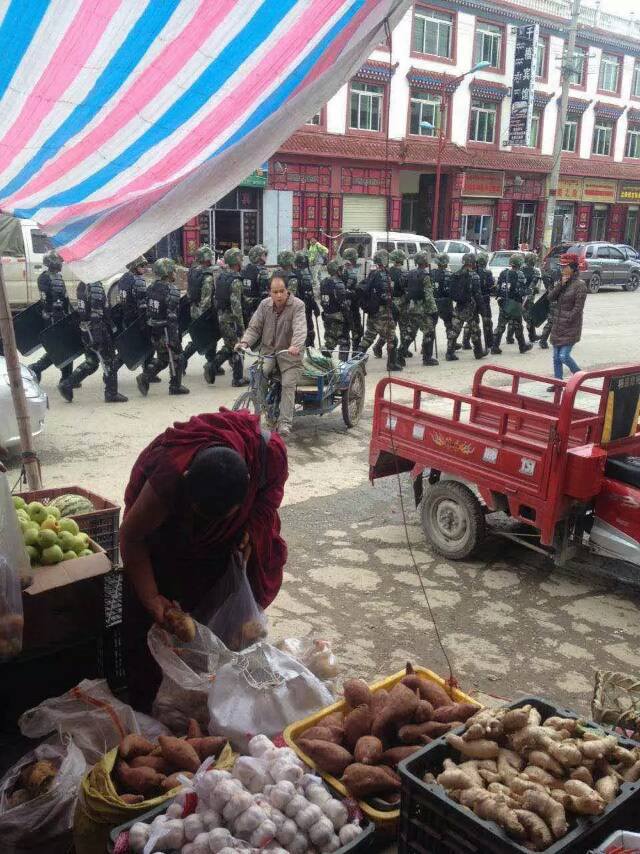 Tibet: Tensions on the roof of the world
Tibet: Tensions on the roof of the world
By Matt Rivers, CNN – 29 December 2016
Lhasa, Tibet (CNN)It’s dawn in Lhasa, Tibet, and the quiet is punctuated only by the gentle chanting of Buddhist pilgrims.
They pray outside the Jokhang temple, Tibetan Buddhism’s holiest place.
Some prostrate themselves on the cool stone ground, while others walk clockwise around the temple, spinning hand-held prayer wheels.
The thick, sharp scent of incense hangs heavy in the air.
We’re watching all this from the side, mere silent observers to rituals honed over hundreds of years.
More restricted than North Korea?
The early morning calm belies the region’s tumultuous history.
The Communist government in Beijing has controlled Tibet since 1951. After a failed revolt against Chinese rule in 1959, the 14th Dalai Lama — Tibet’s spiritual leader — fled to India.
Simmering defiance from Tibetans who remained sometimes boils over into large-scale riots.
Activists say more than 140 people have lit themselves on fire in protest of religious and cultural suppression since March of 2009.
It’s a side of Tibet the Chinese government doesn’t want outsiders to see. Beijing requires all foreign tourists to have permits and sometimes shuts down access for weeks at a time. It only rarely allows reporters to visit the region.
However, in early September, CNN was among a small group of journalists invited on a five-day, government-led trip to what China calls the Tibetan Autonomous Region.
It was the first time a CNN team had been allowed to visit Tibet since 2006. By comparison, CNN has been to North Korea, often referred to as the hermit kingdom, more than a dozen times in the same period.
We were allowed in only under the watchful eye of government minders, who packed our days with activities — art classes, operas and an international tourism expo.
What we saw … and didn’t see
The lack of access to anything controversial or the ability to ask any real questions was a theme of our trip.
When we met Tibet’s vice chairman, Penpa Tashi, the most senior official we encountered, we hoped to be able to pose some tougher questions.
Instead, we were forced to sit silently as he spoke for 80 uninterrupted minutes, talking about how everyone in Tibet is happy and content — a picture in stark contrast to the one painted by human rights activists.
We also asked to visit a Buddhist monastery during our stop in Nyingchi, a town near the border with India, but were told there were none nearby.
A quick Google search brought up a Chinese state media article from just two weeks earlier, showing a photo spread from a monastery in the same area, a mere 15 miles (24 kilometers) from where we were.
We asked our minder about that too, and he simply shrugged and ignored our question.
All in all, Lhasa, Tibet’s capital, felt like most other Chinese cities I’ve visited — safe, busy and very much in Chinese control.
A tinderbox
For people who track daily life in Tibet, demonstrations of dissent are just a spark away from being reignited.
“Tibet is one of the regions in China where political oppression and religious oppression are at the highest point,” says Nicholas Bequelin, East Asia Director at Amnesty International.
Much of the tension stems from concerns over the influx of Han Chinese — China’s dominant ethnic group — into Tibet.
In 1964, there were just 39,500 Han Chinese in the remote region, just under 3% of the population, according to scholars. That figure now stands at 245,000, according to the 2010 census figures.
While this is less than 10% of the population, Han Chinese traders, workers and investors have mainly settled in Lhasa, where they control many businesses and fill better-paying jobs — deepening resentment with Tibetans.
Nearly every shop we visited appeared to be owned by Han Chinese.
Economic inequality
The government has invested billions of dollars into transforming the region, focusing on building new infrastructure, schools, and modern medical facilities.
We saw a new multi-lane highway being built between Lhasa and Nyingchi.